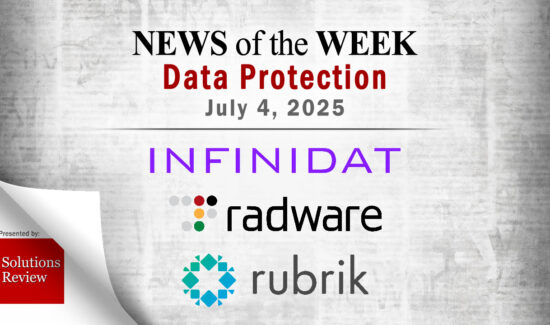What’s Changed: 2022 Gartner Magic Quadrant for Enterprise Backup and Recovery Software Solutions


The editors at Solutions Review highlight what’s changed since the last iteration of Gartner’s Magic Quadrant for Enterprise Backup and Recovery Software Solutions and provide an analysis of the new report.
Analyst house Gartner, Inc. has released its 2022 Magic Quadrant for Enterprise Backup and Recovery Software Solutions. Gartner defines the marketplace as “Enterprise backup and recovery software solutions are designed to capture a point-in-time copy (backup) of enterprise workloads in on-premises, hybrid, multi-cloud and SaaS environments and write the data to a secondary storage target for the purpose of recovering this data in case of loss.” The analyst’s focus in this space is on transformational technologies and approaches.
Gartner goes into detail to list what it believes to be “core capabilities” among backup and recovery solutions, including: backup and recovery for operating systems, files, databases, and applications in the on-prem data center, backup and recovery of public cloud IaaS, PaaS, and SaaS as well. Core capabilities also encompass the creation of multiple copies of the backup to support resiliency, disaster recovery, and other use cases like aligning multiple backup and retention policies with recovery objectives.
Enterprises looking for additional functionality than what Gartner mentions in its core capabilities can sometimes be provided by the solution. These more forward-thinking features can also include other workloads like containers, edge, and remote branch office sites, as well as endpoints. Some of the best backup and recovery providers offer tiered backup data to multiple targets, and backup for data discovery, compliance, copy data management, ransomware protection, and orchestrated disaster recovery.
Gartner highlights the following providers in the enterprise backup and recovery software solutions market: Veeam, Commvault, Veritas Technologies, Rubrik, Dell Technologies, Cohesity, IBM, Arcserve, Druva, HYCU, Acronis, Zerto, Unitrends, and Micro Focus. Gartner adjusts its evaluation and inclusion criteria for Magic Quadrants as software markets evolve. As a result, HYCU was added to this report for 2022.
In this Magic Quadrant, Gartner evaluates the strengths and weaknesses of 20 providers that it considers most significant in the marketplace and provides readers with a graph (the Magic Quadrant) plotting the vendors based on their ability to execute and completeness of vision. The graph is divided into four quadrants: niche players, challengers, visionaries, and leaders. At Solutions Review, we read the report, available here, and pulled out the key takeaways.
Not much has changed in the Leaders bracket, as Veeam once again holds the top spot in the enterprise backup and disaster recovery space. Veeam offers a broad array of backup capabilities, support for Kubernetes containers, and workload and platform services as well. Commvault held serve as the runner-up in 2022 by offering comprehensive workload support, flexible deployment options, and broad geographic coverage. Commvault is best suited for large, enterprise use cases. Veritas also remains tightly grouped with the Leaders as a result of its multiple deployment options, cloud-native architecture, and large enterprise and multi-geography focus.
Rounding out the Leaders quadrant, and in the same order as the 2021 report are Rubrik, Dell Technologies, and Cohesity. According to Gartner, Rubrik touts ease of deployment and use, excellent ransomware protection and recovery capabilities, and widespread enterprise adoption. Dell Technologies is strong in its cyber recovery vault deployments, PowerProtect Data Manager enhancements, and foundational relationship with VMware. Cohesity is best known by Gartner analysts for unified and simplified management, threat defense, and flexible licensing options.
The Challengers column remains unchanged for 2022 as well, though IBM did put some additional ground between itself and Arcserve with a move up-and-to-the-right on the graph. IBM is unique due to its OpenShift container backup, comprehensive portfolio selling, and product strategy, which sees the mega-vendor bundle various data protection products. Arcserve offers a secure appliance solution, immutable storage option, and even provides clients a free copy of Sophos Intercept X with purchases of its popular appliances.
With HYCU’s exit from this Magic Quadrant, Druva and Acronis make up the whole of the Visionaries quadrant. Druva actually gained some in Gartner’s horizontal axis for Ability to Execute. Druva offers a mature SaaS-based Backup-as-a-Service solution called Data Resiliency Cloud, comprehensive data management features, and popular consumption-based pricing plans. Acronis’s strengths come from its integrated cyber and data protection capabilities, support for scale computing, global edge environments, and endpoint protection strategy.
Zerto, Unitrends, and Micro Focus round out this Magic Quadrant from the Niche Players column, and in a similar fashion to 2021. Acquired by HPE in 2021, Zerto offers excellent continuous data protection features, Kubernetes support, and more. Zerto is a converged backup and disaster recovery solution for on-prem and cloud use cases. Unitrends offers unified administration, a growing portfolio of appliances, and integrations with Kaseya’s IT Complete portfolio.





















